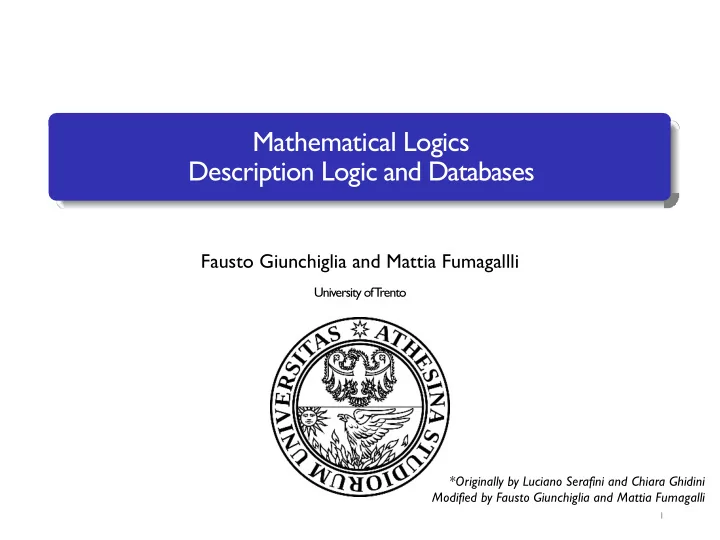

Mathematical Logics Description Logic and Databases Fausto Giunchiglia and Mattia Fumagallli University of T rento *Originally by Luciano Serafini and Chiara Ghidini Modified by Fausto Giunchiglia and Mattia Fumagalli 1
Limitations of databases w.r.t. DL Employee Name Role Nationality Supervises Fausto Professor Italian Rui Rui Student Chinese Bisu Bisu Student Indian - q No negation q No disjunction q Ambiguous support for incomplete information (null values) q The database represents a single model. q Hence, inference is just model checking. 2
Defining a TBox and ABox for a database Employee Name Role Nationality Supervises Fausto Professor Italian Rui Rui Student Chinese Bisu Bisu Student Indian - Individual Class Relation Attribute TBox = {Professor ⊑ Employee, Student ⊑ Employee} ABox = {Professor(Fausto), Student(Rui), Student(Bisu), Nationality(Fausto, Italian), Nationality (Rui, Chinese), Nationality (Bisu, Indian), Supervises(Fausto, Rui), Supervises(Rui, Bisu)} 3
Defining DL theories for ER diagrams q An ER conceptual schema can be expressed as a DL theory q The models of the DL theory correspond to the legal database states of the ER schema. q Reasoning services, such as satisfiability of a schema or of a logical implication, can be performed by the corresponding DL theory. q A DL theory allows for a greater expressivity than the original ER schema, in terms of full disjunction and negation and entity definitions by means of both necessary and sufficient conditions. 4
Defining DL theories for ER diagrams TBox = { Person ⊑ Manager ⊔ Employee, Manager ⊑ Person ⊓ ¬ Employee, Employee ⊑ Person ⊓ ∃ income -1 .Dollar-quantity ⊓ ∃ location -1 .City Dollar-quantity ⊑ Quantity City ⊑ ∃ is-part -1 .Region } 5
DL as Query Language TBox = {} ABox = {Child(John, Mary), Female(Mary)} NL Query: Who are the individuals having only female children? DL Query: T, A ⊨ ∀ Child.Female Answer: {John} q We can think to a database as a DL theory with one model q ABox services are generally applied to resolve a query q Complexity may go up to CO-NP complete 6
How to use ABox Reasoning Services ABox Service Description Query Instance retrieval Given a concept C, retrieve all the instances a A ⊨ C which satisfy C w.r.t. the ABox A. Instance checking Check whether an assertion C( a ) is entailed by A ⊨ C( a ) the ABox, i.e. check whether a belongs to C. A ⊨ R( a,b ) NOTE: this means that before answering we need to expand the ABox (w.r.t. the TBox) and reason on the identified model 7
RECALL: Reasoning via expansion of the ABox q Reasoning services over an ABox w.r.t. an acyclic TBox can be reduced to checking an expanded ABox. q We define the expansion of an ABox A with respect to T as the ABox A’ that is obtained from A by replacing each concept assertion C( a ) with the assertion C’( a ), with C’ the expansion of C with respect to T. q A is consistent with respect to T iff its expansion A’ is consistent q A is consistent iff A is satisfiable, i.e. non contradictory. 8
Answering Queries via instance checking (I) TBox = {Horse ⊑ Animal, Mule ⊑ Animal} ABox = {Horse(Furia), Parent(Speedy, Furia)} NL Query: Is Furia an animal? DL Query: T, A ⊨ Animal(Furia) YES, in fact the ABox can be expanded as follows: ABox = {Horse(Furia), Animal(Furia), Parent(Speedy, Furia)} 9
Answering Queries via instance checking (II) TBox = {Horse ⊑ Animal ⊓ ¬ Mule, Mule ⊑ Animal} ABox = {Horse(Furia), Parent(Speedy, Furia)} NL Query: Is Furia a mule? DL Query: T, A ⊨ Animal(Furia) NO, in fact the ABox can be expanded as follows: ABox = {Horse(Furia), Animal(Furia), ¬ Mule(Furia), Parent(Speedy, Furia)} 10
Answering Queries via instance checking (III) TBox = {Horse ⊑ Animal, Mule ⊑ Animal} ABox = {Horse(Furia), Parent(Speedy, Furia)} NL Query: Is Furia a mule? DL Query: T, A ⊨ Mule(Furia) NO (BY CLOSED WORLD ASSUMPTION), in fact the ABox can be expanded as follows: ABox = {Horse(Furia), Animal(Furia), Parent(Speedy, Furia)} If we drop closed world assumption the answer should be I DO NOT KNOW 11
Answering Queries via instance retrieval: Tableaux (I) TBox = {Horse ⊑ Animal, Mule ⊑ Animal} ABox = {Horse(Speedy), Horse(Furia), Parent(Speedy, Furia)} NL Query: Is there any animal which is not both a horse and a mule, and is parent of a horse? DL Query: T, A ⊨ ∃ Parent.Horse ⊓ ¬ (Horse ⊓ Mule) i.e. is the formula satifiable? 12
Answering Queries via instance retrieval:Tableaux (I) TBox = {Horse ⊑ Animal, Mule ⊑ Animal} ABox = {Horse(Speedy), Horse(Furia), Parent(Speedy, Furia)} Is ∃ Parent.Horse ⊓ ¬ (Horse ⊓ Mule) satifiable? ⊓ -rule A’ = { ∃ Parent.Horse(x), ¬ (Horse ⊓ Mule)(x)} ∃ -rule A’ = {Horse(Furia), Parent(Speedy, Furia), ( ¬ Horse ⊔ ¬ Mule)(x)} ⊔ -rule A’ = {Horse(Furia), Parent(Speedy, Furia), ¬ Horse(Speedy)} inconsistent or A’ = {Horse(Furia), Parent(Speedy, Furia), ¬ Mule(Speedy)} consistent 13
Answering Queries via graph reasoning NL Query: Does John have a female friend loving a not female? DL Query: G ⊨ ∃ FRIEND.(Female ⊓ ( ∃ LOVES. ¬ Female))(john) 14
Answering Queries via graph reasoning NL Query: Does John have a female friend loving a male? DL Query: G 1 ⊨ ∃ FRIEND.(Female ⊓ ( ∃ LOVES.Male))(john) 15
Provide the answer for the queries G G ⊨ Grad ⊓ ∃ TEACHES. ⊤ G ⊨ ENROLLED(Mary, cs221) G ⊨ Student ⊓ ∀ ENROLLED. ⊤ G ⊨ Grad(peter) G ⊨ Grad(Susan) G ⊨ ∃ ENROLLED.Grad (ee282) G ⊨ ∀ TEACHES. IntermediateCourse(bob) 16
Recommend
More recommend